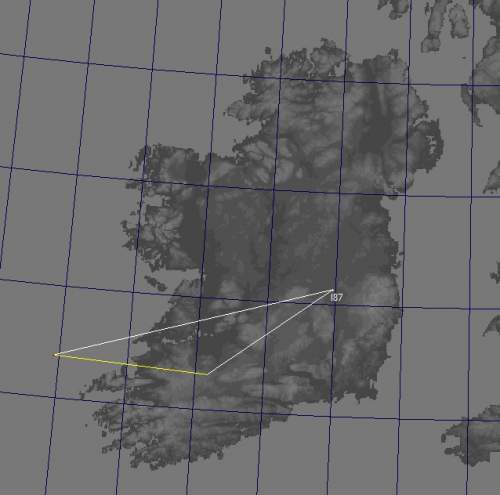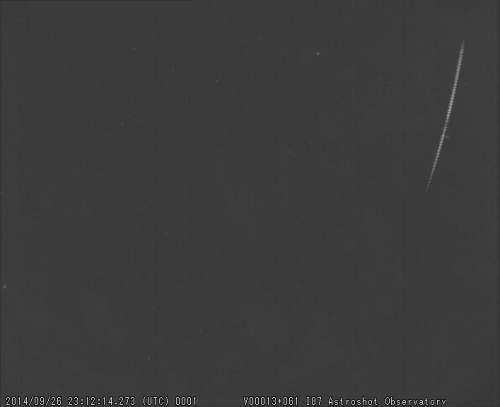SAC Burren Star Party 2014, September 26th-27th
- dave_lillis
- Offline
- Super Giant
-

This is a quick list of some of the objects we saw
M33, triangulum galaxy, 2 spiral arms visible at 81x, they were faint but visible
M51, whirlpool galaxy, spiral arms clearly seen as was the companion galaxy ngc5194, the connecting arm was not seen
M57, ring nebula, very well seen, some speculated that it looked a little green others said they thought it looked a little red !
M13, hercules globular cluster, the big crowd pleaser of the night, at the start of the night we were limited to 278x, but as the night went on we were able to push it up to 500x and still get good star points, this object got alot of woows and omg's at the eyepiece!, lol. At that power it filled the 82 degree fov, it was fully resolved into the core. Some commented we could probably have pushed it beyond 500x if we had the eyepieces, which I don't.
I prefer to run it at a lower power, 378x, this way the outer areas of the cluster are not outside the fov, so it doesn't looked so cropped.
M92, globular cluster, smaller and visibly fainter then M13, the center point of the core is much more concentrated, very different shape to M13, it was fully resolved into the core, max best magnification at 357x
M15, I really like this cluster, looks very uniform and not as fragmented as M13, it was fully resolved into the core. max best magnification at 357x
M56, globular cluster in lyra, fainter and smaller then the ones above, was best seen at 298x, the scope managed to resolve it.
ngc869/884 double cluster in perseus, got both in the fov at 81x, the very conspicuous orange star was visible lying between the 2 clusters and after abit more searching, several more blatantly orange stars were spotted, the individual clusters them selves were better seen at 179x
ngc6888, soap bubble nebula in cygnus, this was almost invisible without filters, it popped into view with the use of an O3 and was still there in a UHC filler but fainter. With the O3 filter the entire shape of the oval was visible as were hints of wisps and tendrils inside the nebula, resembled photographic shape/outline
ngc6992/6990 veil nebula in cygnus, this is all but invisible unless we used the O3 filter, when using the filter the veil simply appeared!, it was brightest around the eastern side near the star 52 cygni, we used 81x to get as much of it in the fov as possible and as we panned the scope to the western side, we encountered wisps and areas of nebulosity, more and sharper detail was visible at 179x, at that power we were able to see its veil namesake and knots and arcs in the fainter sections, the only way to describe it all would be to look at a narrow band image of it.
M31/32+ngc205 Andromeda galaxy and satellite galaxies, at 81x the main dark lane was clearly visible and m32 was in the same fov, it was bright overall but its usual diffuse almost featureless self
M81/82 galaxy pairing in ursa major, M82 was best seen at 179x where we could see the dark central lane, at 81x we got both in the same fov, M81's core was visible but not its spiral arms
M27, dumbbell nebula, it was best seen unfiltered where we were able to count 9 stars easily enough inside the red section (photographically) of the nebula, although we didn't see any colour, its dumbbell shape was easily seen. Using an O3 filter, the fainter regions were visible and it took on more of a spherical shape.
NGC7293, helix nebula, it was completely invisible in the fov until we applied the O3 filter, it then took on its photographic appearance and shape with a dark central region, it was very low in the sky so no central star was visible, I used 96x for this as 179 was too big as it filled over half the fov and this reduced its contrast, I'd say this would be a super object if it was alot higher in the sky
Uranus/Neptune, Uranus was a definite pale blue disk at 278x, Neptune was decidedly bluer and around half the size, been low in the sky we couldn't push the power any higher.
Albireo in cygnus, double star, I always have a quick look at these just to see the amazing color contrast, its like looking at 2 lights through colored glass, the blue and yellow colours were blindly obvious even the newbies there.
Alcor/Mizar, this was easily seen and was shown to demonstrate a contrast to Albireo
Vega in lyra, at the request of some of the kids there that night, we pointed the scope at vega, it was quiet striking and had the 4 spikes caused by the secondary mirror support vains, the type you see in long exposure images, its blue-white colour and extreme brightness made for a striking almost arc-welding like view.
M37 open cluster in Aquila, one of my favorite clusters, a bright and very evenly illuminated wide dense expanse of stars with a very striking orange star in the center, all the other stars in the cluster appear white, the contrast makes for a striking view, one person likened it to a cake with a cherry on top
M36/38, 2 open clusters in Auriga, both of these are similar in that they are not dense and not soo big, not striking and very inferior to M37
NGC7000, north american nebula in cygnus, much too big to fit all in the fov at the same time, it was very hard to detect at 81x. The edges of it were much more detectable using a h-beta filter, especially around the gulf or mexico area.
M29/39 open clusters in cygnus, both of these were bright but sparse,
M71 globular cluster in sagitta, a bright but very diffuse globular cluster, it was almost swallowed up in its starfield, best seen at 179x,
NGC457, a nice bright open cluster in cassiopeia, some refer to this as the "ET cluster", a good mix of several bright stars and alot more fainter stars., best seen at 179x
ngc7009, saturn nebula in aquarius, it was quiet low but its distinct shape was visible, no filters were needed.
so as you can see, we mainly stayed on deep sky objects
Dave L. on facebook , See my images in flickr
Chairman. Shannonside Astronomy Club (Limerick)
Carrying around my 20" obsession is going to kill me,
but what a way to go.
+ 12"LX200, MK67, Meade2045, 4"refractor
Please Log in or Create an account to join the conversation.
- michaeloconnell
- Offline
- Administrator
-

- Posts: 6332
- Thank you received: 315
Conn Buckley wrote: Michael, Yes, I was in the Burren and saw a very bright one and while I did not think to check the time I am fairly sure it was shortly after midnight. It was definitely traveling East to West and it's flight path was just above a line connecting Alpheratz and Markab at the East and West corners of the square of Pegasus.
It first caught my attention when it was East of Alpheratz (about where M31 is) and it fizzled out just West of Markab leaving what looked to me as a smoke trail illuminated briefly by it's own brightness.
Duration? ….. it seemed to me like 2 or 3 seconds but long enough for me to shout to others the customary ' Wow look at that'. It was way brighter than anything else in the sky at the time and I would hazard a guess that it was at least as bright as Venus which I think is about Mag. -4/5 as Frank reckoned.
For me the most striking thing about it was it's colour and I saw it as green. Can they be green?
You say that your camera caught it so I would be interested to know if you can confirm the colour.
The observing site at the Burren offers the darkest night sky I have ever seen and even the most ordinary stars/constellations seemed brighter than what I am used to so I wondered would this cause me to exaggerate the brightness?
That's interesting.
Attached are a ground map and composite shot of all frames of the avi.
Note that the ground map is approximate only.
First detected at 00:12:10 BST
Disappeared at 00:12:16 BST
so, 6 secs in total, which is quite long.
The camera is mono for sensitivity.
However, I have visually seen green meteors before.
Green may indicate that it was primarily composed of metal, rather than stony.
I use UFO Capture to record the meteors and then process them in UFO Analyser.
sonotaco.com/soft/e_index.html
Excellent software which is widely used by the amateur and professional meteor community.
If two stations record the same meteor, UFO Orbit can determine the orbit of
the object back out into the solar system. Pretty amazing software, to be honest!
The software thinks it belongs to the ν-Eridanids and had a velocity of 55km/s.
It estimates a magnitude of 0.4, although I suspect this is on the faint side.
It was a little hazy here at the time, so may have underestimated the magnitude.
Please Log in or Create an account to join the conversation.
- johnomahony
- Offline
- Super Giant
-

- Posts: 1321
- Thank you received: 250
NGC 7000 with death ray
www.flickr.com/photos/7703127@N07/15222572798/
Milky way shots. The first image is a stack of 3 x 13 minutes. The second is a single frame of 3 minutes
www.flickr.com/photos/7703127@N07/15406040361/
www.flickr.com/photos/7703127@N07/15406124591/
The Lord giveth, the Revenue taketh away. (John 1:16)
www.flickr.com/photos/7703127@N07/
Please Log in or Create an account to join the conversation.
- dave_lillis
- Offline
- Super Giant
-

You've really nailed down the art of deep sky imaging.
Dave L. on facebook , See my images in flickr
Chairman. Shannonside Astronomy Club (Limerick)
Carrying around my 20" obsession is going to kill me,
but what a way to go.
+ 12"LX200, MK67, Meade2045, 4"refractor
Please Log in or Create an account to join the conversation.





